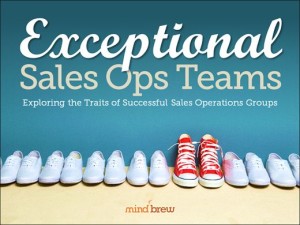Nobody cares how busy you are.
It’s a harsh truth, but the reality is that in today’s world everyone is really busy—or at least they think they are. No one is impressed by the laundry list of things that you did today or this week or this year. That’s true in social settings. And it’s just as true when you are talking to upper management about the sales ops team.
We’ve seen a lot of groups fall into the trap of focusing too much on activity metrics—that laundry list of to-do items. The specific activity metrics tracked vary from company to company, but they all essentially answer the question, “What have you guys been doing all quarter?”
So if your group is responsible for generating RFPs or RFQs, you might report on the number of RFPs or RFQs you’ve completed. If you handle training, you might report on how many training sessions you’ve conducted. If you handle inside sales calls, you might report on the number of calls. If you handle reporting, you might count the number of reports you’ve generated. You get the idea.
Your team might find these numbers interesting. And to a certain extent, activity metrics are important because they can help you determine how efficient your team is and whether you need to adjust headcount up or down.
But to everyone else—including upper management—these numbers are boring as hell. Even worse, focusing on these numbers can actually do damage to sales ops’ reputation in the company and to the team itself. Here’s how:
- Activity metrics look backward. When you spend too much time looking back at what has already happened, you aren’t spending enough time looking at what is happening right now or what will happen in the future. At a bare minimum, you need to look at any activity metrics in the context of how will things are improving, whether that trend is likely to continue, and where you would like your activity metrics to be.
- They present sales ops as a reporting function. While it’s true that every sales ops team does and should do some reporting, your goal should be to add strategic value to the company. If your primary responsibility is to measure what has happened, then sales ops is a cost center. But if your primary responsibility is to improve revenues and margins, then suddenly sales ops looks like the very essential part of the company that it is.
- They can build animosity with the sales team. Nobody likes a tattle-tale. If any of your activity metrics paint the sales team in a bad light, you’re going to be increasing the conflict between two groups that need to collaborate closely in order to be effective. Don’t ever forget that sales ops and the sales team are on the same side.
- They can lead to false assumptions. It’s great that your team sent out 100 RFPs this quarter, but what if only 2 percent of those RFPs led to actual deals? Focusing on the number of RFPs you completed makes it seem like the best way to increase revenue is to increase the number of RFPs you turned around. In actually, it might be much more helpful for the team to spend more time completing the smaller set of RFPs where you actually have a fighting chance. Winning 10 percent of 50 RFPs is a lot better than 2 percent of 100 RFPs, or even 2 percent of 200 RFPs.
- You’ll get more of what you measure. If your team is evaluated on how much stuff they do, then they will busily do a lot more stuff—whether or not it contributes to the bottom line. But those busywork tasks probably aren’t going to make a huge difference on the overall success of your firm.
So if activity metrics are the wrong place to focus, what’s the right place?
The very best place to focus is on output metrics. For example, instead of leading with the number of training sessions you’ve done, tell management how each training session improved the performance of sales reps. Maybe your new onboarding system helped reps meet their quotas two months earlier. Maybe negotiation training helped your sales reps meet price targets 25 percent more often. Put hard numbers to these improvements, focusing on how they directly impacted revenues and margins.
When executives understand that each training session you’ve conducted added an impressive dollar amount to quarterly profits, they are going to be much more interested in investing in the capacity to conduct more training.
It all comes down to how well sales ops is helping the company achieve its goals. If you align your goals and metrics with the overall objectives of the company, you’ll find that you’re not only contributing much more value to the company, it’s easier to demonstrate that value to leadership.
If you’d like to learn more about the importance of picking the right metrics, watch the webinars on Demonstrating the Value of Sales Operations and Measuring the Financial Impact of Sales Ops, or read the express guide to Sales Metrics Sales Leaders Should Be Managing. All three of these resources can help you pick the right numbers to measure if you want your sales ops team to be highly effective.














